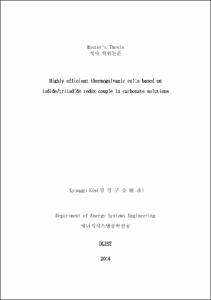Highly efficient thermogalvanic cells based on iodide/triiodide redox couple in carbonate solutions
- Title
- Highly efficient thermogalvanic cells based on iodide/triiodide redox couple in carbonate solutions
- Alternative Title
- 카보네이트계 전해액/요오드 레독스 반응 기반 고효율 열전기화학전지
- Author(s)
- Kim, Kyung Gu
- DGIST Authors
- Kim, Kyung Gu ; Lee, Ho Chun ; Kim, Dong Hwan
- Advisor
- Lee, Ho Chun
- Co-Advisor(s)
- Kim, Dong Hwan
- Issued Date
- 2014
- Awarded Date
- 2014. 2
- Type
- Thesis
- Subject
- thermo-galvanic cell ; iodide based redox couple ; carbonate system solvents ; Seebeck coefficient ; Power conversion efficiency ; 열화학전지 ; 지벡값 ; 효율 ; 카보네이트계 용액 ; 아이오딘
- Abstract
-
Around the globe, a demand of the gasoline and electricity is elevated and also prices of them are increasing. A lot of wasted thermal energies (below 100℃) all over the world have been recycled such as geothermal, sun light, power plants, and engines. To decrease the carbon emissions from utilizing fossil fuels, wasted low grade heat energies can be alternative on underground resources; coal, petroleum, natural gas.
Thermo-galvanic (TG) cell is electrochemical cell in which the identical electrodes are held in electrolyte at different temperature. It converts thermal energy to electric energy directly without carbon emission, utilizes the ambient low grade heat under 100℃, and has very simple design. Liquid-based thermo-electro-chemical technologies offer an alternative, potentially cheaper and more scalable route for direct thermal-to-electric energy conversion with no carbon emissions. In this study, to find out the maximum values of power conversion efficiency(PCE), Seebeck coefficient (SC) and Output power, we utilize numerous concentrations of I3-/I- redox couple by mixing various volume ratios of solvents such as EC (ethylene carbonate), DEC (diethyl carbonate), EMC(ethyl methyl carbonate), and DMC (dimethyl carbonate). We also experiment the existing aqueous system of TG cell with some changes such as electrode area and temperature difference to make same conditions with our organic TG cell, and display the aqueous TG cell to compare with our organic TG cell after optimizing the PCE, SC, and output power.The PCE with MWNT electrodes / Carnot efficiency is shown to be 1.4 % in the literature, which is the highest one in the current field of TG cell. In our study, we foun 4.83 % of PCE/ Carnot efficiency at 1.2 M I3-/I- redox couple in EC/DMC (0.25/9.75,v/v %). ⓒ 2014 DGIST
- Table Of Contents
-
Ⅰ. INTRODUCTION 1 --
Ⅱ. THEORITICAL BACKGROUND --
2.1 Seebeck coefficient 7 --
2.2 Figure of Merit and Power conversion efficiency 8 --
2.3 Soret effect 9 --
2.4 Cyclic voltammetry 9 --
2.5 Operating mechanism 9 --
Ⅲ. EXPERIMENTAL --
3.1 Electrode 11 --
3.2 Electrolyte 11 --
3.3 Preconditioning process 12 --
3.4 Power properties and open circuit voltage measurements 12 --
Ⅳ. RESURT AND DISCUSSION --
4.1 Fe(CN)64− /Fe(CN)63− redox couple in aqueous solution 14 --
4.2. I3-/I- redox couple in organic solution 17 --
4.3. Comparison of aqueous and organic solution system 23 --
4.4. Thermal conductivity 25 --
4.5 Comparison on iodide based organic solution with Pt electrode and Fe(CN)64− /Fe(CN)63− aqueous solution with MWNT electrode 27 --
4.6 Interaction between a linear carbonate and iodide 28 --
Ⅴ. CONCLUSION 31
- URI
-
http://dgist.dcollection.net/jsp/common/DcLoOrgPer.jsp?sItemId=000002262537
http://hdl.handle.net/20.500.11750/1345
- Degree
- Master
- Department
- Energy Systems Engineering
- Publisher
- DGIST
- Related Researcher
-
-
Lee, Hochun
- Research Interests Lithium-ion batteries; Novel Materials for rechargeable batteries; Novel energy conversion;storage systems; Electrochemistry; 리튬이차전지; 이차전지용 신규 전극 및 전해액; 신규 에너지변환 및 저장 시스템; 전기화학
-
- Files in This Item:
-
 기타 데이터 / 1.4 MB / Adobe PDF
download
기타 데이터 / 1.4 MB / Adobe PDF
download
- Appears in Collections:
- Department of Energy Science and Engineering Theses Master



